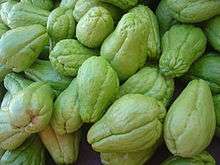Puerto Rican cuisine
Puerto Rican cuisine has its roots in the cooking traditions and practices of Europe (mostly Spain), Africa and the native Taínos. Starting from the latter part of the 19th century. Puerto Rican cuisine can be found in several other countries.
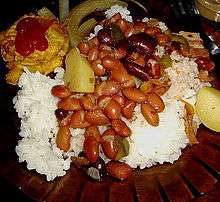
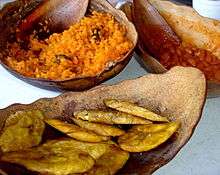
| Part of a series on |
| American cuisine |
|---|
|
Regional cuisines |
|
Ingredients and foods
|
|
Ethnic and cultural |
|
Holidays and festivals |
|
History
Puerto Rican cuisine has been influenced by an array of cultures including Taino Arawak, Spanish, and African.[1] Although Puerto Rican cooking is somewhat similar to both Spanish and other Latin American cuisine, it is a unique tasty blend of influences, using indigenous seasonings and ingredients. Locals call their cuisine cocina criolla. By the end of the nineteenth century, the traditional Puerto Rican cuisine was well established. By 1848 the first restaurant, La Mallorquina, opened in Old San Juan.[2] El Cocinero Puertorriqueño, the island's first cookbook, was published in 1849.[3] On November 1, 2004 a book titled Puerto Rico: Grand Cuisine of the Caribbean, was released in Spanish and English. The cookbook is a dedication to Puerto Rico's rich gastronomic and chefs sharing old and new recipes. The book features not only native Puerto Rican chefs but chefs from all over who have been influenced by Puerto Rico's cuisine calling it "the gastronomic capital of the Caribbean".[4]
Taino influences in Puerto Rican cuisine
See: Native American cuisine
From the diet of the Taíno (culturally related with the Maya and Carib peoples of Central America and the Caribbean) and Arawak people come many tropical roots and tubers (collectively called viandas) like yuatía (Xanthosoma) and especially Yuca (cassava), from which thin cracker-like casabe bread is made and pasteles Puerto Rico's version of tamale. Ajicito or cachucha pepper, a very mild chili known for it smokeyness, recao/culantro (spiny leaf coriander), sarsaparilla, avocado, pimienta (allspice), achiote (annatto), peppers, ají caballero (the hottest pepper native to Puerto Rico), peanuts, guavas, pineapples, jicacos (cocoplum), quenepas (mamoncillo), lerenes (Guinea arrowroot), calabazas (West Indian pumpkin), and guanabanas (soursops) are all Taíno foods. The Taínos also grew varieties of beans and some maíz (corn/maize), but maíz was not as dominant in their cooking as it was for the peoples on the mainland of Mesoamerica. This is due to the frequent hurricanes that Puerto Rico experiences, which destroy crops of maíz, allowing more safeguarded plants like yuca conucos (hills of yuca grown together) to flourish. Maíz when used was frequently made into cornmeal and then into guanime, cornmeal mixed with mashed yautía and yuca and wrapped in corn husk or large leaves. Food was cooked on a barbecue grill made of logs over a pit of flame. To the Taínos this was known as barbacoa.
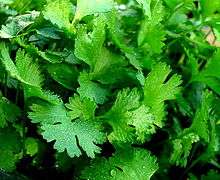
Spanish/European influence
See: Spanish cuisine
Spanish/European influence is also prominent in Puerto Rican cuisine. Wheat, chickpeas (garbanzos), black pepper, onions, garlic, cilantro (using plant and seeds in cooking), basil, sugarcane, citrus fruit, grapes, eggplant, lard, chicken, beef, pork, lamb, goat and dairy all came to Borikén (Puerto Rico's native Taino name) from Spain. Olives, capers, and olive oil play a big part in Puerto Rican cooking, but cannot be grown under the tropical climate of the island. The island imported most of these foods from Spain along with some herbs. Early Dutch, French, Italian, and Chinese immigrants influenced not only the culture but Puerto Rican cooking as well. This great variety of traditions came together to form La Cocina Criolla.
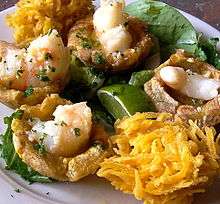
African influence
See: African cuisine
Coconuts, coffee (brought by the Arabs and Corsos to Yauco from Kafa, Ethiopia), orégano brujo, okra, tamarind, yams, sesame seeds, gandules (pigeon peas in English), many varieties of banana fruit, other root vegetables and Guinea hen, all came to Puerto Rico from, or at least through, Africa. African slaves also introduced the deep-frying of food, such as cuchifritos.[5]
United States influence
See: Cuisine of the United States
The US influence on the way Puerto Ricans cook their meals came about after Puerto Rico became a territory of the United States as a result of the Treaty of Paris of 1898. The most significant influence has to do with how people fry food. The early Spaniards brought olive oil for cooking and frying, but importing it from Spain made it very expensive, and cooks on the island shifted over to lard, which could be produced locally. For 50 to 60 years, corn oil produced in the United States took the place of lard for making cuchifritos.
Galletas de soda (soda crackers in tins, popularly known as export sodas from a popular brand name) are a U.S. product of the 19th and early 20th centuries that reproduce the crunchy texture of the earlier casabe bread, and can be kept crunchy in the tins in high tropical humidity.
American / streaky bacon has also played a big part in Puerto Rican cuisine. It is used in rice, stewed beans, and to stuff mofongo and meats such as whole chicken and the breast. Bacon in Puerto Rico has found its way into traditional foods such as arroz con gandules and potato salad. Another meat that has found its way onto the Puerto Rican table from the U.S. is turkey (pavo), which is not native to the island but a common holiday meal next to the older lechón, roasted whole and seasoned using either sazón or adobo, often served with a side of blood sausage and ripe plantains.
Latin American influence
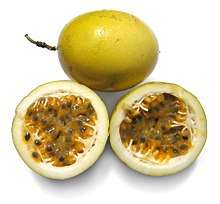
Other foods native to Latin America were brought to the island with the Spanish trade, such as cocoa, tomatoes, chayote, papaya, bell peppers and vanilla from Mexico and Central America. Potatoes and passion fruit were also brought over by the Spanish or Portuguese from Peru and Brazil.
Other influence
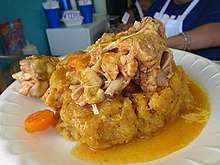
Panapén (breadfruit) was first imported into the British Caribbean colonies from the South Pacific as cheap slave food in the late 18th century. After spreading throughout the Antilles, panapén has also become an indispensable part of the Puerto Rican repertoire, in puddings, deep-fried tostones and making mofongo.
Regional
The topography of the main island is divided into three major regions: the mountainous region, which includes the Cordillera Central, Sierra de Luquillo, Sierra de Cayey and Sierra Bermeja, the coastal plains and the northern karst region. Every regional and municipality has its unique gastronomic traditions.
Arecibo
Arecibo is the biggest municipality in Puerto Rico by area and is located on the northern coast. Arecibo is known for its heavy use of cumin and coriander seeds making dishes smokey and flavorful. In the river of Río Grande de Arecibo whitebait called cetí is caught.[6] These small fish are used in mofongo, alcapurrias, empanadas, but more famously battered and deep fried. One restaurant in Arecibo is known for a pastele filled with cetí. These pasteles are made of yuca, yautía, squash and coconut milk, wrapped in banana leaf and grilled.
Hatillo
The town of Hatillo is located on the north coast, about an hour west of San Juan. It is called the Dairy Capital of Puerto Rico, with almost as many cows as people. The town produces about one third of the milk consumed in Puerto Rico. Hatillo is the only place in the Caribbean to produce cheese equivalent to European cheese. Every cheese is name after a part in Puerto Rico or honor a destination in Puerto Rico. These cheeses are unique to Puerto Rico and can only be made in Hatillo, Puerto Rico.
Loíza
Loíza is a town and municipality on the northeastern coast of Puerto Rico. The town is known for its African traditions and was the center for African slave trade in Puerto Rico. Its Afro-Puerto Rican cuisine has a unique Taíno touch and technique. The use of coconut is heavily used in sweet and savory dishes: empanadas made from yuca dough, coconut milk and filled with seafood; yellow rice with coconut and seafood; green papaya salad a rare find and a tradition that is dying out. The papaya is picked green and boiled. Whatever greens are available are tossed with the papaya, lemon or lime. Sweet plantains and the some of the papaya seeds are sometimes incorporated. There are also sweets such as dulce de coco (sweet milk coconut), cazuela (a sweet potato, pumpkin and raisin pie cooked with coconut milk and banana leaves), and dulce de ajonjoli (a sesame brittle, sometimes with almonds and coconut). Pasteles, rice and coconut arepas, toasted cornmeal arepas, yuca bread with garlic and coconut or cheese, mofongo and guanime are some of the most popular dishes coming from Loíza. The cuisine of Loíza has influenced not only all of Puerto Rico but throughout the Caribbean.
Basic ingredients
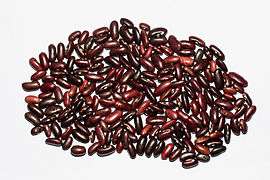
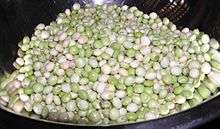
Grains and legumes
- Black beans/Habichuelas Negras – Popular with the Cuban community in Puerto Rico.
- Coffee/Café
- White beans (navy beans)
- Lima beans
- Corn/Maíz
- Pigeon peas/Gandules
- Chick peas/Garbanzo
- Green beans
- Green peas
- Red kidney beans/Habichuelas rojas
- Pink beans/Habichuelas Rosadas – Most common bean in Puerto Rico.
- Pinto beans
- Rice/Arroz – White medium-grain rice is the most popular type of rice. Long-grain rice is used as well but mostly with Puerto Ricans living in the United States. Pearl rice is used for rice pudding. It's a sweet, sticky rice with much starch making it perfect for puddings and other sweets. Rice flour is also used in making fritters and custards.
- Sesame seeds/Ajonjolí – These are used mainly as a snack. Tropical-fruit-flavored lollipops with bit of whole sesame seeds in them. Turrón de ajonjolí a sesame bar made with brown sugar, honey and other ingredients. Horchata de ajonjolí a milky drink made with ground sesame seeds.
- Tamarind/Tamarindo
Herbs
- Basil/Albahaca
- Bay leaves – Laurel
- Cilantro
- Marjoram/Mejorana
- Mint/Menta
- Plectranthus amboinicus/Orégano brujo – This oregano, with its distinctive pungent aroma, grows wild on the island. It is mainly used dry, and is a key ingredient in adobo seco and adobo mojado.
- Parsley/Perejil
- Culantro/Recao – Eryngium foetidum. Similar to cilantro but stronger in flavor.
- Sage/Salvia
- Tarragon/Estragón
- Caribbean thyme/Tomillo – Same flavor as English thyme, but stronger flavor.
Starchy tropical tubers
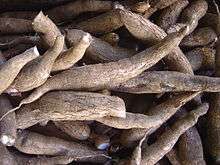
Starchy tubers, starchy fruit, chayote, and squash are all known as viandas or verduras. They are all treated the same, whether boiled or made into chips and served with mojo or mashed with butter and milk. Mofongo is popular with all viandas but mostly plantain. They can be roasted, made into soups (especially cream soups), breads, pastelillos dough, or used in desserts.
- Apio – Root vegetable (from the legume Apios tuberosa / Apios americana), eaten like potatoes.
- Batata/Tropical sweet potato – Purple flesh but white inside.
- Lerén/Arrowroot
- Malanga/Taro
- Ñame/Yam
- Papa/Potato – A few varieties of potato existed on the island.
- Yautía/Eddoe – A few varieties of this root existed on the island.
- Yuca/Cassava – Similar to a potato but starchier.
Vegetables
- Asparagus
- Cabbage
- Calabash
- Carrot
- Cauliflower
- Chayote
- Eggplant/Berenjena
- Green onions
- Lettuce
- Onion
- Shallot
- Watercress
- West Indian pumpkin
Meats and poultry
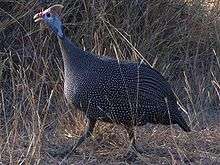
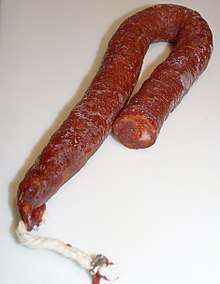
- Beef
- Butifarra – A common Spanish sausage.
- Carne bif – Corned beef is usually stewed with potatoes served with fried sweet plantains and white rice. Corned beef stew is also used as a filing for alcapurrias or served with sorullos.
- Chicken – The second most popular meat eaten on the island after pork. Wild chicken can be seen all over the island.
- Chorizo – A common Spanish sausage.
- Duck
- Goat
- Geese
- Guinea hen
- Ham – Ham is an important part of Puerto Rican food. Searing ham in annatto oil is considered the first step in cooking a proper sofríto and recaíto.
- Lamb
- Longaniza – A common Spanish sausage.
- Blood sausage – Known as morcilla. Adopted from the Spanish morcilla. Puerto Rican morcilla contains rice, culantro, cilantro, chillies and garlic.
- Oxtail
- Pork, such as pernil – Every part of the pork is used.
- Salchichón – Puerto Rican salami. Contains mostly of heart, tripe and livers from beef and meat from pork. Other ingredients include black pepper corns, paprika and annatto.
- Vienna sausages/Salchichas – They were introduced in 1898. Today, they are scrambled with eggs and cooked in other dishes. Very popular cooked in rice as arroz con salchichas or stewed separately and served with white rice as Salchichas Guisadas (sausage stew).
- Spam
- Turkey
Seafood and shellfish
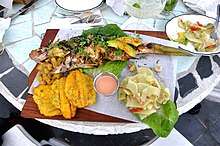
On certain coastal towns of the island, such as Luquillo, Fajardo, and Cabo Rojo, seafood is quite popular, although much of it is imported. Only a tiny number of fishermen ply the waters off Puerto Rico today, and their catch never leaves their seacoast towns. The fact that the island sits next to the deepest part of the Atlantic means there is no wide continental shelf to foster a rich offshore fishery; neither are there any large rivers to dump extra nutrients into the sea that could build up a fish population.
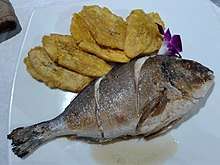
Fruits
Fresh tropical fruit is important in the traditional daily diet in Puerto Rico
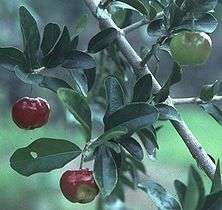
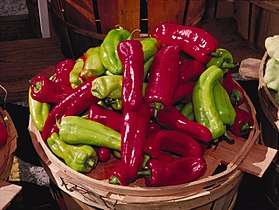
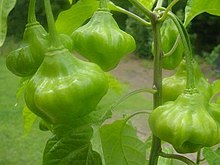
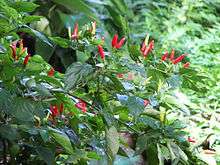
- Acerola cherry
- Sugar apple/Anón
- Avocado – Grows practically wild, is commonly consumed in salads.
- Bananas/Guineos – There are many different types of bananas throughout the island. Ripe and unripe bananas are used in savory and sweet dishes and beverages.
- Chrysophyllum cainito/Caimito
- Orangelo/Chironja – Combination of orange and pomelo, the original name for the grapefruit, and is a native fruit of Puerto Rico.
- Citrus – There are many types of citrus fruit grown and used on the island. Lime, lemon, bitter orange, and oranges being the most widely used for juicing and marinating meats.
- Coconut/Coco – Probably the most common dessert ingredient. Many delectable desserts are made with its milk (leche de coco), including coconut flan, coconut cream desserts, crunchy coconut squares, coconut meringue, candied coconut rice, and coconut bread pudding (boudin de pasas con coco).
- Carob - This fruit was brought over by the Spanish. Its used to make desserts, drinks and syrup. Most notably for crème caramel (flan), Malta, cookies, limbre and ice cream.
- Custard apple/Corazón
- Cucumber
- Frambuesas – raspberries (Rubus rosifolius)
- Guava
- Jackfruit
- Jobo – A refreshing orangy yellow fruit with a spiky kernel
- Mamey – This fruit was almost extinct; until recently when it began to be cultivated again. It is very popular among the Cubans and Dominicans who live in Puerto Rico. Its pulp is vermilion-colored and it is excellent for use in juice and ice cream.
- Quenepa
- Mammee Apple – It is often used to make syrup-based preserves and desserts, although, when very ripe, it is also eaten raw. It is indigenous to America and was already acclimated to Puerto Rico at the time of Christopher Columbus' arrival.
- Mango
- Nance
- Okra/Quimbombó – Arrived from Africa and is eaten stewed as well as fried, pickled, in soups and in salads.
- Papaya
- Passion Fruit/Parcha
- Pineapple/Piña – Native fruit to the island. Puerto Rico grows four varieties of pineapple.
- Pepper – From sweet to hot peppers are an important part of Puerto Rican cooking. Most meals are made with a combination of sweet, mild, and slightly hot peppers.
- Pomarrosa – Appelroo (Tropical apple / Syzygium malaccense)
- Pomegranate
- Sea Grape
- Soursop/Guanábana
- Starfruit/Carambola
- Tomato
- Melon – Many varieties grow on the island from sweet to bitter. Most common in salads and juicing.
Starchy fruits
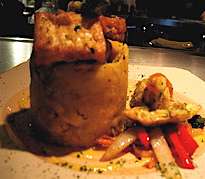
- Breadfruit/Panapén – Used the same as green plantains and also in desserts.
- Green Banana/Guineo – Used in soups, eaten along with popular starchy root vegetables and occasionally broiled and seasoned with escabeche.
- Plantains/Plátanos – Core components in any Puerto Rican meal are plantains (plátanos), a type of savoury banana that is only eaten cooked: tostones are fried plantains usually served as an appetizer or starchy side dish. Mofongo is the best-known plantain dish and essential eating, at least once. The ripe version of the plantain is often fried and eaten as a side dish (maduros).
- Dwarf Puerto Rican plantain – The heads of fruit are a little larger than the original Plantain bearing seven to nine hands of fruit. The shorter trunks of the dwarf plantains are thicker than the tall ones and because of this are more resistant to the wind and rarely fall over from the weight of their own fruit. It is widely grown in Puerto Rico for its taste and cooking qualities. The majority of plantains grow tall, but this one is an exception. It has a distinctive bronze colored trunk and leaves. Plant in a warm and well-protected site with optimal growing conditions.
- Dwarf Red – One of many red-skinned banana cultivars on the island, however this one stays short and takes up little space. Most red bananas are much esteemed for good tasting fruit, and this one is no exception. This cultivar also has red pseudostems. The red bananas take longer to ripen than most, it will take up to 24 months to fruit. The banana has a very distinct, robust flavor that makes it well worth the wait. This red banana's skin turns sunset colors through the ripening process from yellow-green to orange then to red. The skin should be almost very dark red before it is ripe enough to eat.
Hot sauce
A traditional pique (hot sauce) is an oil and vinegar based sauce that is infused with whole peppers, garlic, onions and maybe culantro or other spices. Traditionally found in every restaurant, pincho stand, and corner market.
- Coco loco - Coconut hot sauce made with coconut water, cream of coconut, toasted coconut meat, lime, molasses, chilies and other ingredients.
- Kookoo - Mango and habaneros that have been smoked on a grill with added smoked paprika, cumin and other ingredients.
- Parcha Apasionada - Habanero, caballero, naga, Thai and cayanne hot peppers, passion fruit pulp, vinegar, onions, garlic, olive oil, orange juice, lemon juice, cilantro, culantro, salt, oregano, paprika, parsley and basil.
- Pique verde boricua – Green lime hot sauce with much cilantro, culantro, green chilies, green cubanelle peppers, green bell peppers and sometimes avocados.
- Pique criollo – a vinegar based Puerto Rican hot condiment.
- Pique de piña or Buena piña - a fermented and pickled pineapple skin hot sauce.
- Platano loco - Crazy plantain hot sauce. Made with boiled or grilled tomatoes and sweet plantains then fermented in vinegar, spices, garlic, onion, bay leaves, ginger, chilies and lemon juice.
Condiments
Puerto Rican cooking has a large range of spices and seasoning due mostly to influence, this makes Puerto Rico one of the best in Latin fusion cooking. Caribbean and other curries can be found but not as common as sazón and adobo. Traditional cooking on the island uses more fresh and local ingredients such as citrus to make mojo and mojito isleño and especially fresh herbs, vegetables and peppers to make recaíto and sofrito.[7] Star anise, ginger, cinnamon, nutmeg and other sweet spices are mainly used for drinks and desserts.
Puerto Rican dishes are well seasoned with combinations of flavorful spices. The base of many Puerto Rican main dishes involves sofrito, similar to the mirepoix of French cooking, or the "trinity" of Creole cooking. A proper sofrito is a sauté of freshly ground garlic, tomatoes, onions, recao/culantro, cilantro, red peppers, cachucha and cubanelle peppers. Sofrito is traditionally cooked with olive oil or annatto oil, tocino (bacon), salted pork and cured ham. A mix of stuffed olives and capers called alcaparrado are usually added with spices such as bay leaf, sazón and adobo.[8]
- Aceite de achiote – Annatto (bixa orellana) oil. Annatto seeds are cooked on a low flame with oil of choice or lard. Once oil is tinted red with a slight yellow and orange color pods are then discarded. The oil is refrigerated up to two months. Annatto oil is used in most Puerto Rican dishes.
- Adobo mojado – Garlic, salt, black pepper, olive oil, orégano brujo, vinegar or citrus juice or both.
- Adobo seco – Garlic powder, onion powder, dry orégano brujo, salt, black pepper, and sometimes dried citrus zest.
- Ajilimójili – A very garlicky hot and spicy salsa.
- Alcaparrado – A mix of green olives, peppers, and capers.
- Allspice – This berry spice is native to the Caribbean. Allspice is not used regularly in Puerto Rican cuisine but can be seen in some African influenced dishes. The berry is used more in Puerto Rican voodoo than food.
- Banana and plantain leaves – Both leaves are used for their aroma, flavor, and bonding food. Pasteles, guanimes, steamed or grilled fish, and pork shoulder are a few dishes on the island where banana or plantain leaves are used.
- Criollo – Puerto Rican creole sauce, closely related to American creole sauce. Every part of the Caribbean has their unique take on creole sauce. Throughout Puerto Rico, salsa criollo is done differently. A basic Puerto Rican criollo has recaíto as a base. The recaíto is typically cooked with pork, spices, tomato sauce and some kind of liquid.
- Mojito isleño – A sauce served with fish or shellfish.
- Mojo criollo – A herb sauce of finely chopped cilantro or parsley with garlic, citrus, vinegar and olive oil. Onions and butter are sometimes also added.
- Paprika – Frequently used with sazón seasoning for more color and flavor.
- Pique Sauce- Puerto Rican hot sauce commonly found in nearly every home. Made by steeping hot peppers in vinegar.
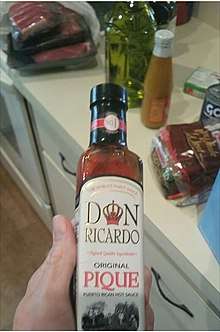 Pique (Puerto Rican Hot Sauce)
Pique (Puerto Rican Hot Sauce) - Recaíto – A green cooking base mix of cilantro, spanish onion, culantro, roasted garlic, green bell pepper and ajicitos.
- Saffron – Used more in high-end Puerto Rican cuisine in restaurants but can replace annatto in dishes.
- Sazón – A seasoning mix consisting of coriander seeds, garlic powder, cumin, salt and annatto powder.
- Sofrito – A mixture of ajicitos, green cubanelle peppers, plum tomato, roasted pimientos pepper, cilantro, Spanish onions, culantro and garlic.
Puerto Rican dishes
Although Puerto Rican diets can vary greatly from day to day and residents tend to indulge in a variety of cuisines, there are some markedly similar patterns to daily meals. Commonly breakfast is simple and small, consisting of coffee and a pastry such as quesitos, a flaky puff pastry filled with a sweet cheese. Dinners almost invariably include a meat, rice and beans.[1] This typical dinner structure leaves room for a plethora of options with choices of meat and rice preparation varying greatly. Traditionally, Puerto Ricans indulge in a wide array of nationalistic dishes as described below.
National dishes
- Arroz con dulce – Sweet sticky rice cooked in spices, ginger, milk, coconut milk, raisins, and rum. National Christmas dessert.
- Arroz con gandules y lechón – Yellow rice with pigeon peas alongside roasted pork is the national dish.
- Asopao – Similar to gumbo, the soup is made with rice, shellfish, chicken, chorizo and other ingredients.
- Coquito – Coconut milk and rum eggnog. National Christmas drink.
- Pasteles – Dough made from stock, green banana, squash, plantains and starch roots, filled with meat and other ingredients. National Christmas dish.
- Piña colada – Made in 1963 at Barra China in Old San Juan, Puerto Rico by Don Ramon Portas Mingot. Ever since it has been the national beverage of Puerto Rico since 1978.
- Tembleque – Coconut corn starch pudding is the national dessert.
Holy Week dishes
During Holy Week before and during Easter, people are encouraged to think more about spiritual matters and eat lightly. Rather than eat meat, they prepare dishes with fish, eggs and dairy.
- Bacalao a la Vizcaína – Salted cod fish stew. The stew is thicker than guisadas but enough liquid to coat rice. The cod is cooked with water and milk, potatoes, raisins, olives, peppers, onions, garlic, tomato sauce, bay leaves and orégano.
- Beverages – Drinks are milk and fruit based. Piña coladas are popular with added evaporated milk and no alcohol. Creamy guava made with sugar, vanilla, lime peels, and evaporated milk are the most consume on holy week. Ripe bananas blended with milk, cinnamon, vanilla, and sugar is prepared at homes as well.
- Caldo Santo – A soup prepared on Easter made with salted cod fish, shrimp, red snapper, crab, coconut milk and viandas.
- Guanimes Con Bacalao – Cornmeal, coconut, and plantain wrapped in plantain leaves and served with salted cod fish stew.
- Habichuelas guisadas y viandas – Stew red beans cooked with recaíto, tomato sauce, olives, spices, carrots, squash, sweet potato, and yams.
- Serenata de Bacalao – Salted cod fish salad. Shredded cod is tossed with dressing, cabbage, avocado, hard boil eggs, onions and a variety of boiled viandas.
- Dulce – Most sweets include cheese and fruit on holy week. Arroz con dulce y queso - sweet rice pudding with cream cheese is becoming more recognized every year, Quesito - a puff pastry filled with cream cheese and fruit, Flan de queso y fruta - flan made with cream cheese and fruit.
Thanksgiving dishes
When Thanksgiving was first celebrated, Puerto Rico was not a part of the United States and did not recognize the holiday. After officially becoming a commonwealth, Thanksgiving was eagerly accepted by the people as their own and has become one of the most celebrated vacations (holidays) of the year. As many regions of the Continental United States have, they've also put their own twist on this classic American tradition.
Most American dishes have been adopted for this special day. Side dishes such as cornbread, roasted yams, mashed potatoes with gravy, hard apple cider, and cranberry sauce are a part of a Puerto Rican Thanksgiving menu.
- Arroz con Maiz y Salchichas – Yellow-rice with corn and Vienna sausage.
- Coquito – Coconut egg-nog rum. A Thanksgiving variation of this traditional Christmas drink can be made by adding pumpkin or chocolate flavor.
- Gandules en Escabeche – Green pigeon peas pickled in vinegar, lemon, olive oil, shallots, herbs, spices, capers, hot and sweet peppers.
- Pasteles – In most Puerto Rican homes, the gathering for pastel making happens a week or two before Thanksgiving. Pasteles are not only prepared for Thanksgiving but enough are made to last until New Year's, making this a timely process that is a cherished social gathering for families. Pork is the most popular pastel for both Thanksgiving and Christmas, but some make "Thanksgiving pasteles" with turkey and dried cranberries.
- Pavochon – Popular from November to January. Roasting a turkey for Thanksgiving in the manner of lechòn (suckling pig) has been a tradition in Puerto Rico since the island became an American commonwealth and adopted the holiday. The word pavochòn is a combination of the Spanish word pavo (turkey), and the word lechòn. To make this dish truly Puerto Rican, the turkey is stuffed with mofongo with added almonds, raisins, olives, hard boiled eggs, and tomatoes. Instead of the thin slices seen in the North, a baked turkey in Puerto Rico is often cut into large blocks or chunks to be served on a plate.
- Dulce – The fusion of American mainland and Puerto Rican food can be clearly seen in Thanksgiving desserts. Puerto Rican desserts use the same traditional ingredients as American holiday desserts including pumpkin, yams, and sweet potatoes. Classic sweets are infused with sweet viandas. Flan de calabasas (squash flan), Tortitas de Calabaza (pumpkin tarts), Cazuela (a pie made with pumpkin, sweet potato, coconut, and sometimes carrots), Barriguitas de Vieja (deep-fried sweet pumpkin fritters made with coconut milk and spices), Cheese cake with tropical fruit, Buñuelos de Calabasas o platáno (pumpkin or sweet plantains doughnuts), and Budín de Pan y calabasas (bread pudding made from squash bread).[9]
Christmas dishes
Puerto Rican culture can be seen and felt all year-round, but it is on its greatest display during Christmas when people celebrate the traditional aguinaldo and parrandas – Puerto Rico's version of carol singing. Puerto Ricans celebrate what is probably the world's longest Christmas. The festivities get underway on 23 November and last until the end of January when the Fiestas de la Calle San Sebastián take place. Puerto Rican food is a main part of this celebration. Christmas expresses the best flavors of Puerto Rico with staple foods, textures, and tradition. Christmas food in Puerto Rico is meant to accommodate every palate.
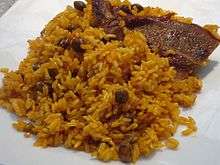
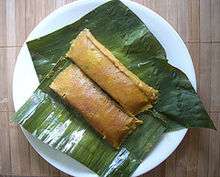
- Arroz con gandules – Yellow-rice-and-pigeon-pea dish. Sofríto and annatto oil plays the biggest part in flavoring and coloring rice. Alcaparrado (capers and olives stuffed with red peppers), pieces of pork, spices, bay leaves, banana leaf and broth.
- Beverages – The official Puerto Rican Christmas drink is coquito, an eggnog-like rum and coconut milk-based homemade beverage. The holiday season is also a time that many piñas coladas are prepared, underscoring the combination of pineapples and coconuts seen in Puerto Rican cuisine. Beer is popular and Puerto Rican style rum punch with sparkling wine and fruit.
- Chuletón – Christmas soup. A variety of beans cooked with sofríto, sazón, pork chops, pork bones, ham, smoked ham hock, salchichón, potatoes, and carrots. This soup is served on Christmas with bread and is not part or the Nochebuena (the good night) festival.
- Escabeche de Guineo con Mollejas – Unripe, green bananas and chicken gizzards pickled in a garlicky brine.
- Pasteles – For many Puerto Rican families, the quintessential holiday season dish is pasteles ("pies"), usually not a sweet pastry or cake, but a soft dough-like mass wrapped in a banana or plantain leaf and boiled, and in the center chopped meat, shellfish, chicken, raisins, spices, capers, olives, sofrito, and often garbanzo beans. Puerto Rican pasteles are made from either green bananas or starchy tropical roots. The wrapper in a Puerto Rican pastel is a banana leaf.
- Lechón – Pork is central to Puerto Rican holiday cooking, especially the lechón (spit-roasted piglet). Holiday feasts might include several pork dishes, such as pernil (a baked fresh pork shoulder seasoned in adobo mojado), morcilla (a black blood sausage), and jamón con piña (ham and pineapple).
- Ensaladas – Most Puerto Rican tables on the holidays have one or two salads. A topical salad would be potato salad with peppers, onions, mayonnaise and with or without chorizo. Macaroni salad with peppers, onions, tomatoes and can tuna or spam. The macaroni is tossed usually in mayonnaise or vinegar and olive oil. Octopus with a citrus vinaigrette and tropical fruits.
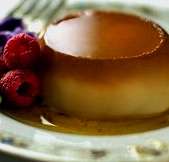
- Dulce – Sweets are common in Puerto Rican cuisine. During the holidays, the most popular are desserts such as Arroz con dulce rice pudding made with milk, coconut milk, spices, ginger, raisins, and rum. Budín de Pan (bread pudding), Bienmesabe - little yellow cakes soaked in coconut cream, Brazo Gitano - Puerto Rican style sponge cake with cream and / or fruit filling, Buñuelos de viento - Puerto Rican wind puffs soaked in a vanilla, lemon, and sugar syrup, Natilla - (spice-milk custard), Tembleque (coconut pudding), Flan (egg custard), Flancocho - cake mix, cream cheese, caramel, and egg custard mix backed together using then flan method, Bizcocho de Ron (rum cake), Mantecaditos - Puerto Rican shortbread cookies, Polvorones - a crunchy cookie with a dusty sweet cinnamon exterior, Turrón de Ajónjolí - a toasted sesame seed bar, bound together by honey and caramelized brown sugar, Mampostiales - very thick, gooey candy bar of caramelized brown sugar and coconut chips, challenging to chew and with a strong, almost molasses-like flavor, Dulce de cassabanana - musk cucumber cooked in syrup topped with walnuts and sour cream on the side, pastelillos de guayaba (guava pastries), Besitos de Coco (coconut kisses), and Tarta de Guayaba (guava tarts).[10]
Appetizers and fritters
Puerto Ricans enjoy fried food and pork. Most meals include fried appetizers, tostones being the island favorite, with rice and bean, stews, soups and other meals. Mofongo with fried pork with stews and soups. Small bit size pastelillos, empanadas or empanadillas are filled with cheese, pork, chicken or beef and can be a start to a meal. Puerto Rico has become popular for their fried food, which can be found in Cuba, Panama, Dominican Republic, and parts of the U.S.
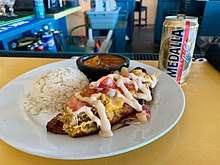
- Almojábana – A fritter made from rice flour, baking soda, cheese (queso blanco, cheddar, or mozzarella), Parmesan cheese, milk and egg. This mixture is used to make a dough that is fried into a ball. This frying is done mostly in the Western region of the island where they can be found for sale in stalls, cafés and festivities. Its preparation, however, is more common during the Christmas season, as an appetizer at parties, although traditionally they are eaten for breakfast by wetting them in coffee. It is also a common in the villages in the central-oeste area and the village of Lares where it is consumed daily for breakfast by many of its inhabitants. Every April, Lares hosts the Almojábana Festival, which includes a crafts fair, live music, and an agricultural fair.[11]
- Croquetas de panapén con bacalao – Fried salted cod fish balls mixed with mashed breadfruit, eggs, butter, roasted garlic and seasoning.
- Macabeos – A green banana fritter. The bananas are boiled and mashed with annatto oil and a small amount of uncooked green banana. They are then filled with any meat of choice, made into small balls and deep-fried. This crescent shaped banana fritter is found mainly in the town of Trujillo Alto, which celebrates a Macabeo festival each year.
- Mofongo – Very popular Afro-Puerto Rican dish made with fried unripe plantain and other root vegetables mashed with garlic, fried pork (chicharrón), olive oil, and broth.
- Niños Envueltos – Boiled and fried unriped lady (finger) banana or red dwarf banana. Once the banana is boiled it is then coated with flour, baking powder, milk, sofrito, orégano and spices. The bananas are then fried until golden-brown.
- Plátanos Maduros – Slices of deep-fried sweet plantains.
Breakfast
Throughout the Caribbean and most of Latin America, it is a common practice to eat stews, fried plantains, rice, beans, flat breads wrapped with fish and boiled mashed plantains with eggs for breakfast. Puerto Rico has adopted a more traditional American breakfast menu including coffee and bread with butter or jam, pancakes, French toast, bacon, breakfast sausage, cold cereals, fresh fruit juice, eggs, and other favorites.
Along with the traditional breakfast favorites, Puerto Rico has added their own flair to the table.
- Arroz con leche – Rice with milk. Rice is cooked until sticky with milk, sugar, and cinnamon. It is then served with fruit.
- Avena – Oatmeal with cinnamon, vanilla, brown sugar, raisins, and milk served with fresh fruit.
- Farina – Cream of wheat cooked with spices, ginger, milk, sugar, citrus peels, and coconut milk. It is served with cinnamon and butter on top.
- Funche o Harina de Maiz – A Puerto Rican dish that is usually served as a breakfast dish. It is boiled coconut milk or coconut cream, milk, salt, and butter mixed with cornmeal until thickened. Sugar, vanilla, and cinnamon is added to give it taste. Funche is served with fruit or nuts.
- Natilla – Cornstarch custard topped with butter and cinnamon.
- Pan de Mallorca – Sweet and light yeast rolls topped with powdered sugar. They are eaten with coffee or stuffed with eggs, cheese and ham.
- Plátanos maduros o Batatas asadas – Sweet plantains or batata (type of sweet potato) baked with spices and served with eggs. Sweet plantains are sometimes mashed with milk and butter.
- Tortilla de Huevos – An omelet made with diced tomatoes, cilantro, onions, peppers, garlic, orégano, and cheese.
Lunch and dinner
Lunch and dinner in Puerto Rico is not particularly spicy, but sweet-sour combinations are popular. Vinegar, sour orange, and lime juice lend a sour touch while dried or fresh fruits add a sweet balance to dishes. Adobo, sofríto and annatto are used in most dishes. Fast food and diners are common for a quick lunch. Food trucks parked on the side of the street that serve sandwiches, churrasco, juices, and soft drinks. The tropical heat hasn't stopped Puerto Ricans from enjoying a good hot soup, usually with tostones, bread, or slices of avocado on top. Some fritters, like almojábanas and yuca con mojo among others, are served with rice, beans, and meat or fish. Slow cooked recaíto and tomato-based stews are a staple in Puerto Rican cooking, served with a side of white rice, salad, and usually something fried like mofongo. Women can be seen in streets, on beaches, and sides of the roads frying a variety of fritters like alcapurrias and bacalaítos. Jucies, piña colada, hotchata and sodas can also be brought at these locations.
- Albondigón – Puerto Rican style meatloaf made with adobo, worcestershire sauce, milk, ketchup, potatoes, red beans, breadcrumbs, parsley, with a hard-boiled egg in the middle.
- Arroz y habichuelas – Rice, invariably accompanied by beans (arroz con habichuelas) or gandules (pigeon peas), is often served as a meal by itself in cheap canteens, and is often considered a stereotype for Puerto Ricans. It's the dish Puerto Ricans feel most nostalgic for overseas and not as bland as it sounds: kidney or pink beans are richly stewed with pork, potatoes, olives, capers, squash, recaíto, spices, broth, and tomato sauce, before being poured over the rice. Arroz junto is a one-pot yellow-rice meat and beans dish. Other rice dishes include arroz con maiz (yellow-rice cooked with corn and occasionally vienna sausage). Coconut rice with fish, arroz con pollo and arroz mamposteao (Puerto Rican fried rice). Pegao de arroz or pegao is the crusty rice left over at the bottom of the pot after cooking it has the most flavor. Pegao is usually eaten with beans and meat. Pegao with other ingredients are made to make granitos (rice and cheese fritter balls) and other fritters.
- Bistec Encebollao – Thinly sliced and pounded steak with onions marinated in adobo mojado and white wine vinegar over night.
- Chillo frito al Mojito Isleño – A whole red snapper seasoned overnight in adobo mojado and onions. Once ready to fry the fish is pat dry then coated with all-purpose flour and plantain chips made into crumbs. The whole snapper is deep-fried and served with tostones, coconut rice, and mojito isleño.
- Chicharrón de pollo – Chicken thighs cut in half and marinated in lemon, rum and garlic with skin still on. The chicken is then tossed in seasoned flour and deep-fried.
- Chuleta Kan-Kan – Deep-fried or grilled pork chop with rib and skin still attached. When done it reassembles a pork chop covered in pork rinds. The skin is sliced cross wise cut to the meat. The chuleta is marinated in culantro, paprika, onion powder and other ingredients.
- Cuajitos en salsa – Spicy pork intestines in a heavy lemon-tomato sauce base served with tostones and sorullos.
- Empanizado or Empanado – Thinly sliced breaded and floured steak, rabbit, turkey, chicken, or veal with peppers, capers, and onions.
- Guisado – Braised meat or fish is quite a favorite on the island. Meat or fish is seared in a pot with annatto oil. Once meat is brown on all side it is then removed. The addition of searing ham and salted pork are common. Recaíto is cooked with left over oil in pot. The meat is then put back with tomato sauce, olives, capers, potatoes, carrots, cumin, coriander seeds, pepper, bay leaves, orégano, wine, stock or beer with water are then added. Guisados are garnished with sweet peas and poured over white rice or mofongo. Pot roast is known as carne mechada (braised beef eye round stuffed with chorizo or ham).
- Fricasé – Hearty and spicy chicken, beef, turkey, rabbit, or goat braised in butter and olive oil with ajíes caballero, wine, raisins, bay leaves, cloves, garlic, onions, bell peppers, tomato sauce, olives, capers, peas, and carrots. Served with rice on the side and cilantro on top.
- Quimbombó con Funche – Okra with a cheese polenta. The okra is usually soaked overnight this extracts most of its liquid. The okra is then dried and seasoned in a batter and fried or made into a stew with ham. Eather way okra is classically saved with polenta known as funche. This is popular on Puerto Rico's sister island Vieques.
- Pastelón – Puerto Rican version of a lasagna replacing the noodles with sweet plantains or less common cassava.
- Picadillo a la Puertorriqueña – Puerto Rican style ground meat used in fritters but can be served with rice and on the side.
- Sandwiches – The Cuban sandwich has been popular ever since many Cubans immigrated to Puerto Rico right after Fidel Castro's rise to power in 1959. Tripleta is a lunch favorite, the sandwich is made with toasted pan de agua (water bread) a Puerto Rican bread similar to Italian bread. Mayonnaise, mustard, ketchup and sofrito mix is then spread on the bread; roasted beef, pork, chicken, cheese, caramelized onions, tomatoes, lettuce, shoe string potatoes or plantains are then added. Jíbarito a sandwich using unripe green plantains as bread. Jíbartia a sandwich using ripe sweet plantains as bread. Mixto it consists of sofrito cooked with both skirt steak and chicken topped with lettuce, tomatoes, and potato sticks with a drizzle of a mix of mayonnaise and ketchup known as mayo-ketchup. Sandwiches de Mezcla is a tea sandwich with a spread made with mayonnaise, roasted peppers, spam, American and cream cheese.
- Sopa y asopao – Soups are typically served with bread, tostones, or a small bowl of rice. Puerto Ricos national soup is asopao, similar to gumbo. This soup is made with rice, chicken, chorizo, or seafood or all three together. Gandinga - a rich, heavy stew made from pig organs. The heart, liver and kidneys all go into the dish, along with less frightening ingredients like tomatoes sauce, capers, and recaíto. Asopao de gandules - pigeon pea soup and dumplings. Mondongo - tripe stew with chickpeas, ham, salted pork tail, calf feet, squash, and viandas. Sopa de salchichón o pollo y fideos - salami or chicken noodle soup with potatoes, corn, sofríto and other seasonings. Cream soups made with heavy cream, broth and mashed squash or any kind of mashed vianda. Caldo gallego - soup made with white bean, chicken broth, chorizo, smoked ham, turnips, kale, and potatoes. Sancocho - one of the most popular hearty stew made with a variety of meats, tubers, corn, and squash. Salmorejo - a cold garlicky tomato and crab soup served with bread. Other popular soups include, black bean soup with bacon (influence by the Cuban community in Puerto Rico), chickpea soup with or without chorizo, chicken broth soup with mofongo, and plantain soup.
Breads, pastries and sweets
- Alfajor – Cassava spiced cookies.
- Bizcocho de Piña Colada – A popular birthday cake made with crushed pineapples, rum, cream of coconut and butter, coconut flakes cream frosting. The cake is then garnished with whipped cream, pineapple slices, and maraschino cherries.
- Bizcocho Mojadito – Moist cake is a very dense almond and brandy cake soaked in a mango, coconut, or guava syrup with a buttery almond frosting.
- Bolitas de Tamarindo – Sweet tamarind balls are found all over the Caribbean and some parts of Latin America in different versions. In Puerto Rico tamarind paste is mixed with milk, coconut milk, honey, brown sugar, rum, and cinnamon. They are formed into small balls and backed. When done they are rolled in white sugar or powered sugar.
- Casquitos de Guayaba con Fruta seca – Guava with skin still on cooked with dry fruit in spices, sugar, and vinegar.
- Cheese Muffins – Muffins made with queso blanco and fruit paste.
- Dulce de Crema de Coco – Dulce de leche cooked in a double boiler with water, cream of coconut, and egg yolks. Once the eggs are cooked to a smooth textures the cream is then strain over a pan layered with lady fingers. Once finished baking the dulce de crema coco is topped with a soft meringue.
- Dulce de Batata – A chewy tropical sweet potato candy.
- Dulce de Piña Colada – Coconut and pineapple fudge. Evaporated milk is cooked slow with ginger, brown sugar, vanilla, shredded coconut, pieces of pineapple and rum.
- Dulce de Leche – In Puerto Rico dulce de leche is commonly made with key lime peels or with added coconut milk.
- Dulce de Papaya con Queso Blanco – unripe green papaya cooked in a heavy syrup with spices served with slices of white cheese.
- Dulce de leche Bars – Puerto Rican style dulce de leche mixed with cream cheese and baked on a cinnamon or chocolate dram cracker.
- Guayaba frita - In Spain leche frita is a dessert served on holy day. In Puerto Rico guava and cream cheese is added to this dessert.
- Gofio – A sweet cornmeal powder snack. Cormeal is mixed with sugar and poured in to a small colorful cone cup. There are many flavours such as coconut powder, cocoa powder, fruit powder, sesame seeds, and cinnamon.
- Limber – Most limbers are milk, egg, and coconut cream base with added fruit flavors and spices. They are frozen in plastic cup or made into popsicles.
- Jibaritos Fritos – Lady (finger) bananas fried in a batter of flour, milk, egg, coconut flacks, vanilla, sugar and cinnamon.
- Majarete – A rice flour custard made with, rice flour, milk, sugar, orange leaves, coconut milk, marshmallow and vanilla dusted with cinnamon on top.
- Marrallo – Fresh shredded coconut made into bars with honey, black sesame seeds and black sesame milk.
- Mazamorra – A fresh corn porridge made with star anise, lime peels, coconut milk, and other spices.
- Panetela – A cake made with guava paste and cheese or coconut jam baked in the middle. The cake is cut into small squares and dusted with powdered sugar.
- Plátanos con Leche – Boiled sweet plantains mashed with milk, sugar, salt, and cinnamon. The dough is formed into small balls, deep-fried and served with ice cream.
- Plátanos en Almibar – Sweet plantains cooked in butter, brown sugar, wine, rum, vanilla, orange peels, and other spices.
- Platanos Maduros con Dulce – Sweet plantain sundae with dulce de leche, coconut ice cream, whipped cream, and a variety of toppings.
- Pilón or Pilones – Puerto Rican lollipops made with tropical fruit. Coconut and sesame seed are commonly mixed with other fruits.
- Queso Blanco con Pasta de Guayaba – White cheese with guava paste served on a soda cracker.
- Ponqué – Similar to pound cake. Ponqué is made with eggs, self-raising flour, coconut milk, evaporated milk, and much butter. Two cakes are usually baked on top and one bottom. In between the layers a syrup made of rum, brandy, almond extract, and vanilla is spread. The frosting is made sugar, egg whites, and lemon zest.
- Tembleque - A pudding containing coconut milk, milk (optional), salt, cornstarch, cinnamon, and sugar.
- Tortilla dulce – Sweet cassava tortilla. Cassava is peeled, grated and squeezed threw a cheese cloth to make a fine flour. The cassava flour is then cooked in milk and left to cool down. Once cool the cassava is then cooked once more with coconut milk, cinnamon, sugar, ginger, butter, and anise. The dough is divided into small balls and flatten onto a plantain leaf that has been buttered. The dough is then cooked in a cast iron skillet until it has browned lightly.
- Tres Leches Cake – A three-milk sponge cake with South American origin. This cake is typically made with milk, heavy cream and evaporated milk. Puerto Rican-style tres leches adds an additional cream of coconut or mango milk and rum.
Beverages
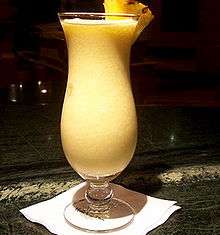
Puerto Rico has a lush tropical climate and due to this fruits, sugar, and coffee grown wild. Coffee is the start of most Puerto Rican homes usually enjoyed with milk and sugar. Fresh fruit drinks and smoothies are typical in restaurants, stands, and homes. There are many drinks that include spices such as coquito, ajonjolí, and mavi. Soft drinks are enjoyed Coco Rico (a company from Puerto Rico that created and produces tropical fruit flavored soft drinks), Kola Champagne, and Malta.
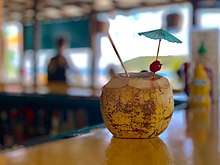
Rum is the islands national drink and over 70% of the rum in the U.S. comes from Puerto Rico. Puerto Rican rum is the biggest and best rum-producing nations in the world. Puerto Rican rum is considered the second best quality in the world after Cuban rum.
- Agualoja – Ginger tea made with ginger, spices, mint, and molasses.
- Bilí – Rum infused with Quenepas, vanilla, cinnamon, ginger, brown sugar and a variety of spices. The mixture is put in a bottle or coconut, wrapped and buried in the ground for a month to a year. Bilí is especially popular on Vieques.
- Chichaíto – A shot consisting of Palo Viejo brand white rum mixed with anise liqueur, honey and lemon juice. The anise in this slightly sweet drink that masks the flavor of the rum. Some bartenders eliminate lemon and add coffee beans. The drink can be mixed with coconut milk and coconut cream (chichaíto de coco), nutella with evaporated milk (chichaíto de nutella) or any fruit puree.
- Chocolate Caliente – Hot chocolate made with coco, vanilla, milk, spices, small amount of edam cheese, and topped with whipped cream.[12]
- Choco-coco – Cocoa powder and bitter sweet chocolate cooked with coconut milk, brown sugar, vanilla, cinnamon, and clove. The drink is usually garnished with whipped cream, coconut flakes, dulce de leche and chopped nuts of choice.
- Coquito - drink traditionally of the holiday season. Ingredients include: cream of coconut, evaporated milk, condensed milk, white rum, cinnamon and vanilla.
- Frappe tropical – Passion fruit juice, coconut cream, banana, and chunks of pineapple blended.
- Punche de Malta – Malta shook with ice, condense milk, vanilla and raw egg.
- Parcha con china – Passion fruit juice, orange juice, sugar, lime, vodka or rum.
- Piragua – Shaved ice dessert, shaped like a pyramid, covered with fruit flavored syrup.
- Refresco de Avena – Oatmeal drink made with toasted oatmeal, milk, ginger, orange peels, cinnamon, cloves, brown sugar, and vanilla.
- Refresco De Tamarindo – Tamarind drink made with brown sugar, cinnamon, clove, ginger, star anise and if desired carbonated water.
- Spiced Cherry – Puerto Rican version of Cuba Libre. Made with spiced rum, Coca-Cola Cherry, and lime.
Kiosks
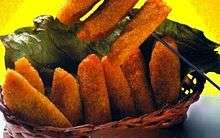

The Luquillo kiosks (or kioskos) are a much loved part of Puerto Rico. Everywhere in Puerto Rico, rustic stalls displaying all kinds fritters under heat lamps or behind a glass pane. Kiosks, are a much-frequented, time-honored, and integral part to a day at the beach and the culinary culture of the island. Fresh octopus and conch salad are frequently seen. Much larger kiosks serve hamburgers, local/Caribbean fusion, Thai, Italian, Mexican and even Peruvian food. This mixing of the new cuisine and the classic Puerto Rican food. Alcoholic beverage are a big part of kiosks with most kiosks having a signature drink.
- Alcapurrias – Fritters that are usually made with a masa mixture of eddoe (yautía) and green bananas (guineos verdes) or yuca, and are stuffed with either a meat (pino) filling or with crab, shrimp or lobster.
- Arañitas – This get their name from their shape, a play on araña, or spider. These shredded green plantain fritters are mixed with mashed garlic, cilantro and fried.
- Arepas or Yaniclecas (from Johnnycake) – The flour flatbread distinct from Puerto Rico. Arepas are usually stuffed with meat, seafood, cheese, rolled or sprinkled with cinnamon and sugar.
- Bacalaítos – Bacalaítos are the codfish fritters from Puerto Rico. Other types of codfish fritters are common throughout the Latin Caribbean world and Spain. They're a staple food at many kioskitos.
- Cuchifrito – Is about as simple a dish. Essentially, slice off a chunk of pork (the ear, the stomach, or the tail), cover it in batter, and deep-fry.
- Empanadilla and pastelillo – Deep-fried turnovers filled with meat, seafood, vegetables, cheese, or fruit paste.
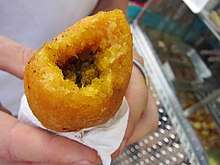
- Papa rellena – A popular Peruvian potato balls fritter stuffed with meat.
- Piononos – Piononos are mashed sweet plantain patties filled with picadillo, or seasoned ground beef, and cheese.
- Sorullos – The cornmeal equivalent of mozzarella sticks, except that they're rather fatter and shorter. They're often made with cheese.
- Taco – These are not the traditional Mexican tacos. Puerto Rican tacos can be described as a cylindrical empanadilla. It is the same dough that's been flavored with annatto and lard, stuffed with beef, rolled-up and fried. In some kiosks there were also one filled with a cheese dog, although it is not a traditional Puerto Rican option.
Puerto Rican food outside the archipelago
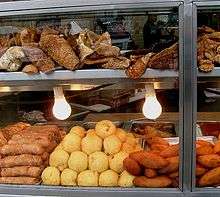
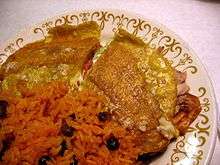
- Cuchifritos – In New York, cuchifritos are quite popular. Cuchifritos, often known as "Puerto Rican soul food" includes a variety of dishes, including, but not limited to: morcilla (blood sausage), chicharron (fried pork skin), patitas (pork feet), masitas (fried porkmeat), and various other parts of the pig prepared in different ways.
- Jibarito (Plaintain Sandwich) – In Chicago, El Jibarito is a popular dish.[13] The word jíbaro in Puerto Rico means a man from the countryside, especially a small landowner or humble farmer from far up in the mountains. Typically served with Puerto Rican yellow rice, Jibaritos consist of a meat along with mayonnaise, cheese, lettuce, tomatoes and onions, all sandwiched between a fried plantain, known as a canoa (canoe). In the early 20th century, bread made from wheat (which would have to be imported) was expensive out in the mountain towns of the Cordillera Central, and jíbaros were made from plantains which are still grown there on the steep hillsides. The version introduced to Chicago was originally made with skirt steak, but today it can be found in versions made with chicken, roast pork, ham, shrimp and even the vegetarian option tofu is available.[14]
Puerto Rican Cookbooks
Cookbooks provide a window into the rich history and culture of a region, and as food policy and nutrition scholar, Melissa Fuster, states “they provide prescriptions for specific dishes and, in some cases, directives on what constitutes a proper meal.” One famous and intently studied Puerto Rican cookbook titled Cocina Criolla by Carmen Valldejuli, does just that. As revealed in Fuster’s article, Writing Cuisine in the Spanish Caribbean: A Comparative Analysis of Iconic Puerto Rican and Cuban Cooks, the cookbook not only has numerous chapters with dozens of recipes dedicated to soups, meats, pasta, sauces, sweets, breads and so on, but it opens with chapters that introduce the reader to the home cook and cooking as an experience. The reader learns that this book was written to act as an instructional manual to be used. Moreover, as Fuster details, cookbook author Valldejuli comes from an elite background, which is mimicked in the sheer number of recipes she includes.[15]
Chefs
- Edgardo Noel – Famous television chef, known for "Cocina al Dia" and "Cocinando y Cantando"
- Dora Romano – author of "Cocine Conmigo[16]" written in 1972
- Carmen Valldejuli – author of Cocina Criolla / Puerto Rican Cookery written in 1954
- Berta Canabillas – author of Puerto Rican Dishes written in 1993
- Daisy Martinez – author of Daisy Cooks: Latin Flavors That Will Rock Your World written in 2005 and Daisy: Morning, Noon and Night written in * of Daisy Cooks! on PBS and ¡Viva Daisy! on the food network
- Oswald Rivera – author of Puerto Rican Cuisine in America: Nuyorican and Bodega Recipes written in 2002
- Yvonne Ortiz – author of A Taste of Puerto Rico: Traditional and New Dishes from the Puerto Rican Community written in 1997
- Maria Perez – author of Tropical Cooking Made Easy [17] written in 2007
- Elizabeth B. K. Dooley – author of Puerto Rican Cook Book written in 1948
- Wilo Benet – author of Puerto Rico True Flavors written in 2007. Competed on Top Chef Masters
- Giovanna Huyke – Famous television chef
- Luis Antonio Cosme – Famous Puerto Rican actor and television chef
See also
- Caribbean cuisine
- Coco Lopez
- Cuisine of the United States
- Cultural diversity in Puerto Rico
- History of women in Puerto Rico
- List of Puerto Rican rums
- Piragua
- Puerto Rican Christmas food
- Street food
- Carmen González (chef)
References
- Albala, Ken (2011). Food Cultures of the World Encyclopedia. Greenwood. p. 656 – via Temple University.
- Porter, Darwin; Prince, Danforth (June 25, 2007). Frommer's Portable Puerto Rico. Wiley. ISBN 9780470100523.
- Ortiz, Yvonne. A Taste of Puerto Rico: Traditional and New Dishes from the Puerto Rican Community. Penguin group, 1997. P. 3
- de Villegas, Jose (2004). Puerto Rico: Grand Cuisine of the Caribbean. La Editorial de la Universidad de Puerto Rico. ISBN 9780847704156.
- "A slice of Puerto Rican history". The Salt Lake Tribune.
- "Historia del Cetí en Puerto Rico y el Caribe". foodiespr.com (in Spanish). February 3, 2015. Retrieved August 25, 2019.
- "The ultimate Puerto Rican food guide". Explore Parts Unknown. October 1, 2017. Retrieved August 25, 2019.
- Taylor, David (June 5, 2020). "Legendary Puerto Rican Cookbook Cocina Criolla begins with many details & Sofrito!". Hispanic Food Network. Retrieved June 22, 2020.
- Ortiz Cuadra, Cruz Miguel (2013). Eating Puerto Rico: A History of Food, Culture, and Identity. Latin America in Translation/en Traducción/em Tradução. University of North Carolina Press. p. 82. ISBN 978-1-4696-0882-2. Retrieved October 12, 2019.
- "Comfort food like none other". La Salita Cafe. Retrieved September 21, 2014.
- "Regresa el Festival de la Almojábana en Lares". Retrieved October 6, 2015.
- Halpern, Ashlea (April 30, 2014). "18 Things to Eat, Buy and Do in Puerto Rico - Casa Cortés ChocoBar". Bon Appetit. Condé Nast.
- "Jibarito Sandwich: What You Need To Know". Retrieved April 28, 2016.
- Bizzari, Amy. Iconic Chicago Dishes, Drinks and Desserts. Arcadia. pp. 46–53.
- Fuster, Melissa (2015). "Writing Cuisine in the Spanish Caribbean: A Comparative Analysis of Iconic Puerto Rican and Cuban Cookbooks". Food, Culture & Society. 18: 659–680.
- Romano, Dora R. de (1972). Cocine conmigo (in Spanish). ISBN 9788439910138.
- Perez, Maria (2007). Tropical Cooking Made Easy. Hillcrest Publishing Group. ISBN 9781934248607.
External links
| Wikimedia Commons has media related to Cuisine of Puerto Rico. |
- Antojo Boricua – Buy Puerto Rican food & coffee online
- El Boricua - Puerto Rican traditional recipes
- Carmen Santiago, Puerto Rican chef
